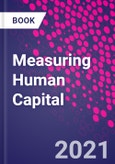Measuring Human Capital addresses a country's most important resource: its own people. Bettering human capital benefits individuals and their country and leads to improved sustainability for the future. For many years economists only used Gross Domestic Product (GDP), now acknowledged to be inadequate without supplemental measures, to gauge a country's overall value. There is now a recognition that many variables contribute to a country's worth, which make accurate measurement difficult. Looking beyond GDP by focusing on human capital, researchers, policymakers, government officials, and students can understand what elements impact human capital and how they might improve it in order to increase economic growth and well-being.
Please Note: This is an On Demand product, delivery may take up to 11 working days after payment has been received.
Table of Contents
I. IntroductionIntroduction
II. Major Measures of Human Capital
II.A. Monetary Measures
1. The Impact of Air Pollution on Human Capital and National Wealth in Developing Countries
2. Global Human Capital: View from Inclusive Wealth
II.B. Indexes
3. The World Bank Human Capital Index
4. Human Development and Human Capital: A Perspective on Concepts and Metrics
5. Summary of Lim, S. S., et al.,"Measuring human capital: a systematic analysis of 195 countries and territories, 1990-2016"
6. Summary of World Economic Forum, "The global human capital report 2017 Preparing people for the future of work"
III. Country Studies
7. Human Capital in Mainland China, Hong Kong, and Taiwan: 1985-2017
8. Accumulation of Human and Market Capital: The Long View, 1948-2013








